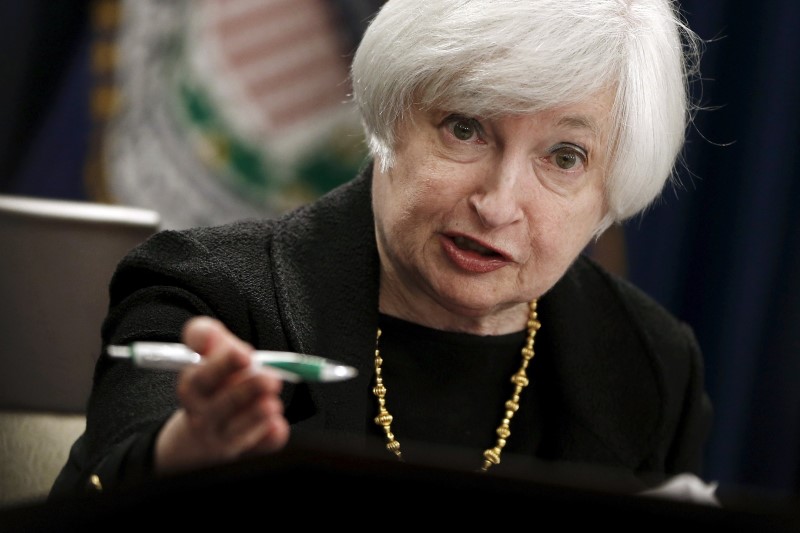Investing.com - The Federal Reserve (Fed) will kick off its two-day meeting on Tuesday with no expectations for a move on interest rates, but eyes were wide open in the hopes of receiving decisive indications for the future path of monetary policy.
“If the Fed is truly data dependent, willing to adjust policy only if the economic data supports the notion, then they will be hard pressed to do anything other than sip coffee and eat doughnuts at their meeting next week,” experts at Alhambra Investment Partners said.
Fed fund futures priced in only a 1.9% chance of a rate hike in June and experts surveyed by Reuters dismissed the possibility with only a 40% chance in following meeting scheduled for July and 80% placing the odds on September.
A dismal May jobs report threw the possibility of a rate hike in the decision to be announced on Wednesday at 18:00GMT, or 14:00ET, out the window as far as Fed fund futures were concerned.
Even though Fed chair Janet Yellen warned on June 6 that one data point did not constitute a trend, she found herself obliged to remove the timeframe of “in the coming months” used in a May 27 speech from when she expected gradual rate hikes to continue.
In this sense, markets will unlikely react to the Fed statement, though the wording will, as always, be perused with a fine-toothed comb.
Furthermore, given Yellen’s most recent speech, it’s unlikely that the following press conference on Wednesday at 18:30GMT, or 14:30ET, will reveal a major shift in the Fed chief’s stance.
Despite these theoretically low expectations for the policy decision this Wednesday, the meeting could be key for defining market expectations.
Dot plot in focus
What is most apt to capture the market’s attention may be, perhaps not the updated economic projections published alongside the statement, but the dot plot that shows Fed officials’ expectations for the future path of rate hikes.
Last March, the median view among Fed officials for interest rate increases was reduced to just two this year, compared to the prior forecast for four that was published in the December meeting when the Fed raised rates for the first time in a decade.
After the May employment report, markets once again priced in just one increase at the December meeting.
The Reuters poll of economists suggested that the second rate hike in the current tightening cycle could come in September.
If the dot plot released on Wednesday was to show that Fed officials still believe there will be two hikes this year, it is difficult to imagine that the central bank would wait beyond September.
As Marc Chandler, global head of currency strategy at Brown Brothers Harriman, pointed out, “When looking at the schedule of (Fed) meetings, and understanding that when the Fed says ‘gradual’ to describe the normalization process, it does not mean hiking at back-to-back meetings, seeing two hikes this year without a summer move is difficult.”
Near-term risk factors
Chandler also demonstrated that modern history since 1980 showed that presidential elections had no effect on the U.S. central bank’s policy decisions despite several commentators’ suggestion that the upcoming November 8 vote could stay the Fed’s hand.
However, a major move on Wednesday ahead of the U.K.’s June 23 referendum on its membership in the European Union (EU) was noted in Yellen’s June 6 speech as a major risk factor.
The possibility of a Brexit, as a decision for Britain to leave the EU is known, “could have significant economic repercussions,” Yellen recognized.
Another possible argument for waiting for September to make a move comes from the fact that the preliminary data for second quarter gross domestic product (GDP) does not arrive until July 29, after the July 27 decision, suggesting that the central bank could wait to confirm current forecasts from the Atlanta and New York Fed for growth of 2.5% and 2.4%, respectively.
Next possible signal on tightening
Assuming that the dot plot will show that the Fed reaffirmed its expectations for two hikes in 2016 and that it will opt to wait for not only the U.K. referendum to pass, but also the GDP data to be confirmed, attention would then shift to August.
There is no policy decision meeting scheduled for that month, but Yellen could easily take advantage of the well-known annual Economic Symposium at Jackson Hole to signal on possible rate hikes ahead of the September meetings.
The event for this year with the title “Designing Resilient Monetary Policy Frameworks for the Future” will take place from August 25-27.
For the moment, the Fed’s policy decision on Wednesday was expected to be a “non-event”, but the dot plot could serve as a key signal for the U.S. central bank’s stance on the future path of monetary policy.
